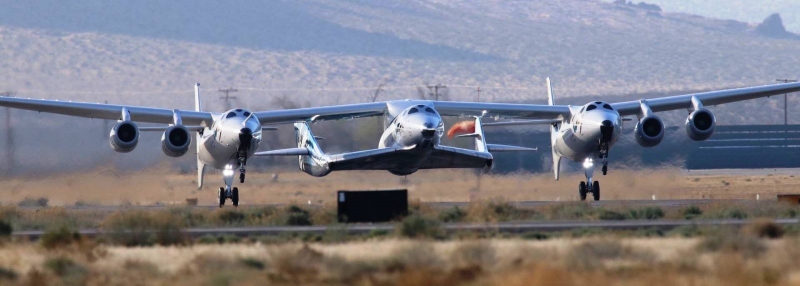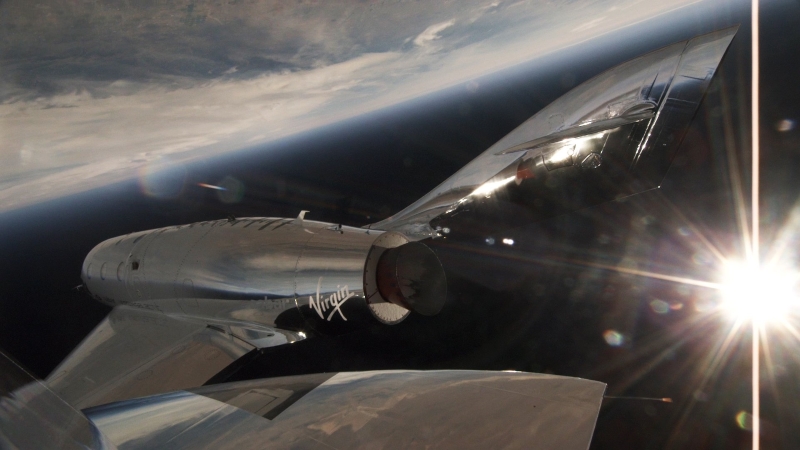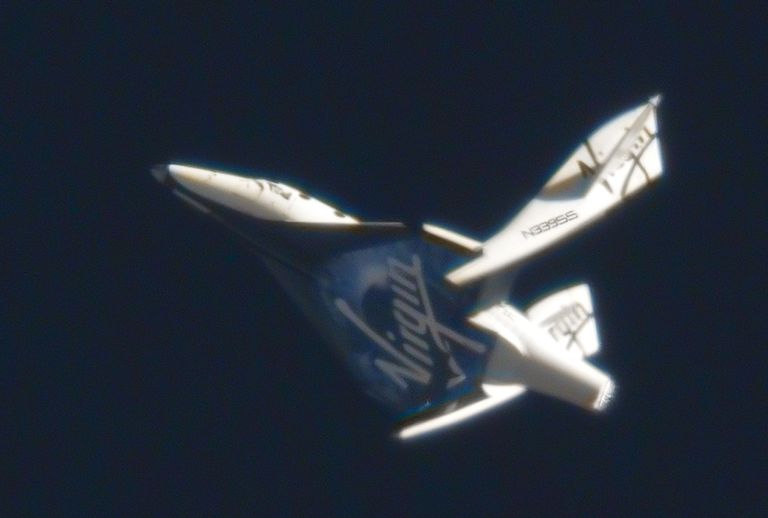On April 4, tests of SpaceShipTwo, VSS Unity, a suborbital space plane, successfully passed an important stage - after separation from the carrier, the engine was turned on, and the device accelerated to 1.87 sound speeds, rising to 25.7 km. This is more than it was possible to achieve on the tests of the first ship before the disaster in 2014. Virgin Galactic has already posted two videos of the flight, where you can see interesting details.
 Shot from video of Virgin Galactic
Shot from video of Virgin GalacticVSS Unity is the second SpaceShipTwo ship. The first, VSS Enterprise,
crashed on October 31, 2014, in which the co-pilot, Mike Alsbury, died. This dropped the test program for years, despite the fact that the development of a suborbital space plane had already been delayed for many years by that time. The investigation
showed that the cause of the crash was a crew error, which arose in the context of design flaws and problems with documentation and testing processes - the co-pilot unlocked the brakes of the braking system too early, and the tail boom drives did not cope with aerodynamic loads. At some point, the question even arose whether Virgin Galactic could even recover from this blow, but the company found the strength and resources to complete the second copy of the ship, which, as announced, eliminated the shortcomings that contributed to the catastrophe. Now the control system does not allow prematurely unlock the braking mechanism.
In the ill-starred flight of 2014, a new type of fuel was tested. The fact is that in the first version of the suborbital spaceplane, SpaceShipOne, which successfully climbed to an altitude of 100 km in 2004, stood a hybrid rocket engine using polybutadiene with hydroxyl end groups (HTPB) as fuel and nitrous oxide as an oxidizer. HTPB is similar in texture to rubber and does not burn completely evenly. There was a shaking, which was tolerant on the small SpaceShipOne, but became dangerous on the larger SpaceShipTwo. In VSS Enterprise flights, the engine was turned on for a maximum of a few seconds. Fuel decided to replace solid polyamide. However, the tests did not really work out - the very first flight with a new fuel ended in disaster. The engine had nothing to do with it, however, in 2018, VSS Unity decided to return to the old fuel - HTPB. It seems that over the past years, engineers have found some way to make shaking from uneven burning acceptable.
 Takeoff of SpaceShipTwo with VMS Eve carrier aircraft, photo Virgin Galactic
Takeoff of SpaceShipTwo with VMS Eve carrier aircraft, photo Virgin GalacticThe flight on April 4 was the twelfth in the test program, running from 2016. Four times VSS Unity was raised on a carrier without separation. Seven times the spaceplane was dropped and planned, landing independently. In the ninth flight on board, they took 450 kg of water as ballast and began to drain it, changing the centering of the device during the flight. In the eleventh, immediately after the separation, VSS Unity was sent to a steep peak, reaching a speed of 0.9 sound.
 Shot with onboard cameras, photo Virgin Galactic
Shot with onboard cameras, photo Virgin GalacticAn interesting feature of the flight was the performance of the half loop - the device all increased the pitch angle until it turned upside down. Most likely, such a maneuver will be used to demonstrate to the passengers the beauty of the Earth from above - there are windows in the ceiling of the cabin, but not in the floor.
 Shot from the second video, image of the Virgin Galactic
Shot from the second video, image of the Virgin GalacticIt is curious that in both videos a beautiful moment of deceleration is cut out by folding the tail beams.
 One of the flights VSS Enterprise, photo Virgin Galactic
One of the flights VSS Enterprise, photo Virgin GalacticBut to make a conspiracy that there was no braking in reality, there is no point. Even on the first spaceplane, aerodynamic calculations were checked in real flight — the device smoothly picked up speed with the engine turned off and unlocked beam locks. The drives of the tail beams cannot hold them, starting from a certain speed and loads, and the oscillations of the beams were recorded at about the estimated time point.
Today, there are two clear leaders among companies offering suborbital tourism services - Blue Origin with the New Shepard and Virgin Galactic with SpaceShipTwo. Until now, no company has begun to carry tourists, and, despite the catastrophe and a delay of several years, Virgin Galactic has not left the race. Blue Origin is in no hurry and prefers to conduct a full cycle of tests. If you compare ships, it turns out quite funny - New Shepard is safer and generally better designed (it even has
really huge windows). But SpaceShipTwo has the elusive charisma of the winged apparatus and the appealing madness of Bert Rutan's designs. I would like to hope that the market of suborbital launches will be large enough for both devices, but only practice will answer this question, so far any options from dozens of companies launching tourists can feel a few minutes of weightlessness, to the utter lack of demand for the service itself.